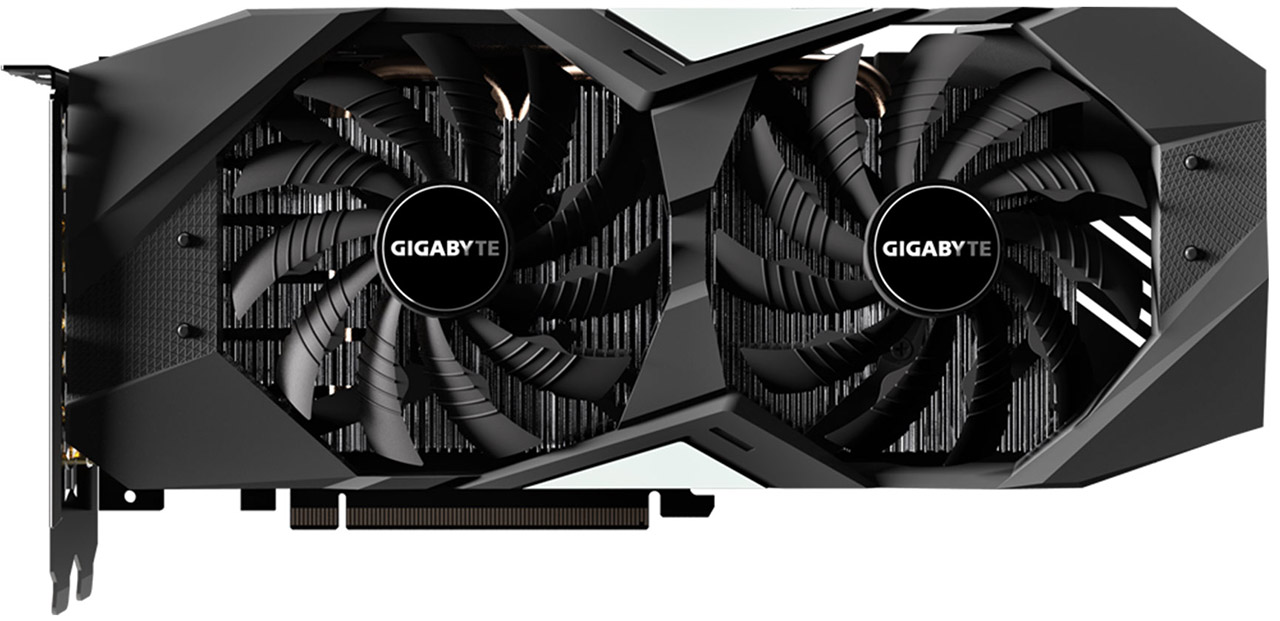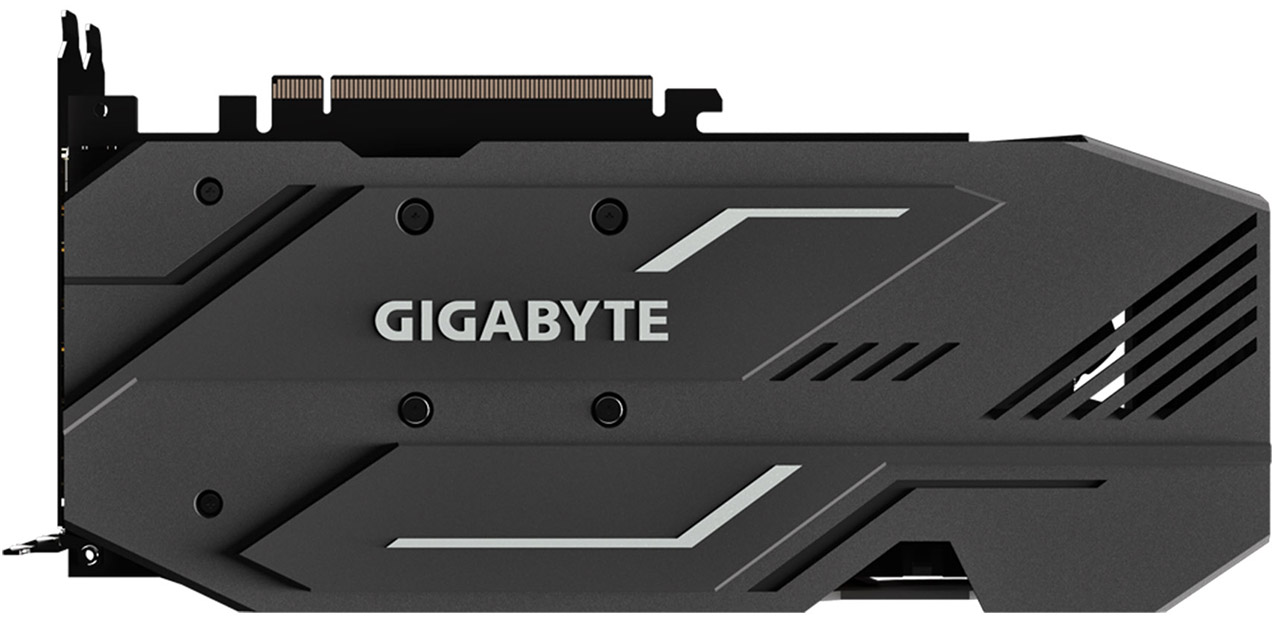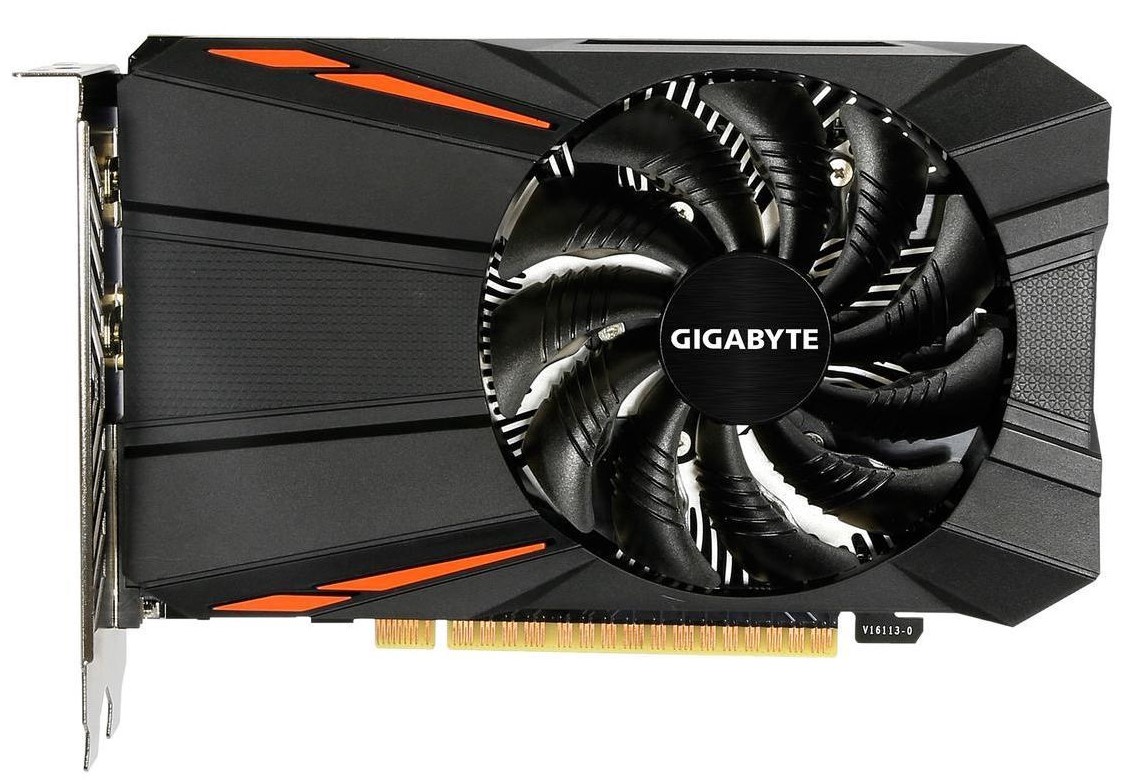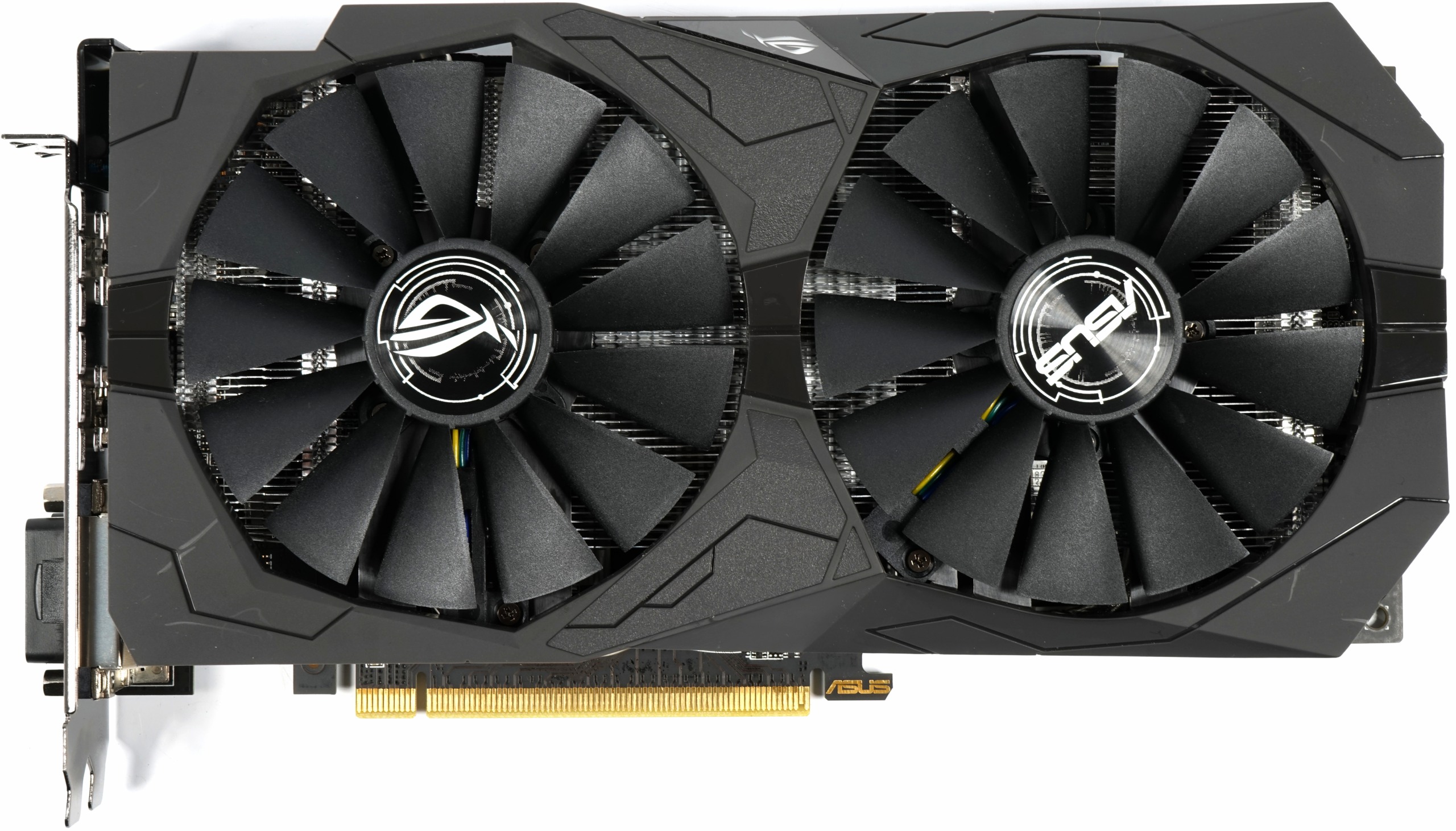Nvidia GeForce GTX 1650 4GB Review: This Turing Fails the Test
Why you can trust Tom's Hardware
Meet Gigabyte's GeForce GTX 1650 Gaming OC 4G
The GeForce GTX 1650 launch is being driven by Nvidia’s board partners. There won’t be a Founder’s Edition card. Rather, companies like Gigabyte are introducing a range of models representing multiple price and performance points. Today’s review covers the GeForce GTX 1650 Gaming OC 4G, Gigabyte’s top-end $180 model that lands just $40 under the base-level Gigabyte GeForce GTX 1660 OC 6G. The company also has $170 (Windforce OC 4G), $160 (OC 4G), and $150 (Mini ITX OC 4G) versions available.
As we continue making our way down Nvidia’s Turing-based product stack, it should come as no surprise that lower prices are accompanied by more cost-conscious designs. The GeForce GTX 1650 Gaming OC 4G isn't a slouch, though. From the front, it’s apparent that Gigabyte employs an aluminum heat sink topped by a Windforce 2X cooler. The plastic fan shroud houses two 100mm fans spinning in opposite directions.
Gigabyte’s PCB is about 7 ⅞” (20cm) long. However, the fan shroud and backplate extend beyond its edge, resulting in a ~10 ½” (26.5cm) length measurement. The GeForce GTX 1650 Gaming OC 4G is also relatively tall, measuring 4 ¾” (~12cm) from the bottom of the PCI Express slot to its top edge. A double-slot form factor is ideal for compact enclosures. There’s little reason, in our opinion, for a mainstream card to take up any more room than that.
Flipping the card over, a plastic backplate bears Gigabyte’s logo and adds a decorative touch over the PCB. There is no contact between the plate and any of the components underneath. Moreover, a bit of ventilation toward the backplate's rear does little to cool the PCB since it's cut out past where the board actually ends. This piece of plastic is mostly decorative, meeting the fan shroud’s bezel in the back.
Up top, the tall PCB dips down to keep your six-pin power connector from protruding too far. The connector is also rotated 180 degrees to avoid interfering with overhanging plastic pieces. Gigabyte's logo is back-lit and compatible with the company's RGB Fusion 2.0 software. Next to it, Nvidia’s GeForce GTX branding is molded into the plastic.
By choosing not to expose dual-link DVI, Gigabyte is able to fit a unique combination of three HDMI outputs and one DisplayPort connector on its slot bracket, plus leave tons of room for ventilation. For some reason, though, Gigabyte moves away from the horizontally-oriented fins we saw on its GeForce GTX 1660 OC 6G and instead utilizes vertical fins that guide warm air down toward your motherboard and up against the fan shroud. Holes cut into the second slot bracket do little to encourage airflow, then.
With the backplate and sink removed, we see that Gigabyte’s cooler is more than just aluminum. A pair of flattened, copper pipes run through the center, right above TU117. They bend to the right and left, dissipating heat evenly through the array of aluminum fins. There are no thermal pads covering the voltage regulation circuitry or memory modules this time around; only Nvidia's GPU touches the sink.
Get Tom's Hardware's best news and in-depth reviews, straight to your inbox.
Peeling away those pads allows us to identify on-board components. TU117 is centered in the middle of Gigabyte's PCB and flanked on two sides by a quartet of Micron MT51J256M32HF-80:B memory modules rated for 8 Gb/s data rates. They're the same ones used on GeForce GTX 1660, just two fewer.
The GPU’s power supply is composed of three phases controlled by a uP9509 on the PCB’s back side. Each phase utilizes a pair of Alpha & Omega AON6354 trench power MOSFETs and one AON6594.
Ubiq Semiconductor’s uP1542 buck controller handles the memory's voltage regulation circuitry, again, by way of two Alpha & Omega AON6354 trench power MOSFETs and one AON6594.
Clearly, this is a different PCB design than what we saw from EVGA’s GeForce GTX 1660 Ti XC Black Gaming or Gigabyte's GeForce GTX 1660 OC 6G. There are no vacant pads on the board for additional phases or extra GDDR5 memory modules. The design is decidedly spread out in comparison, with its six-pin power connector way off to the upper-right corner.
How We Tested Gigabyte’s GeForce GTX 1650 Gaming OC 4G
GeForce GTX 1650 is now the most entry-level graphics card in Nvidia’s Turing-based portfolio. As such, our graphics workstation, based on an MSI Z170 Gaming M7 motherboard and Intel Core i7-7700K CPU at 4.2 GHz, is apropos. The processor is complemented by G.Skill’s F4-3000C15Q-16GRR memory kit. Crucial’s MX200 SSD is used as well, joined by a 1.6TB Intel DC P3700 loaded down with games.
As far as competition goes, we’re most interested in comparing the 1650 to Nvidia’s GeForce GTX 1050 Ti and 1060, along with AMD’s Radeon RX 570. Of course, comparisons to GeForce GTX 1660 and 1660 Ti are inevitable as well. Those cards are included in our line-up, as are GeForce RTX 2060, GeForce GTX 1070 Ti, and 1070. On the AMD side, we’re also interested in Radeon RX Vega 64, Radeon RX Vega 56, and Radeon RX 590.
Our benchmark selection includes Ashes of the Singularity: Escalation, Battlefield V, Destiny 2, Far Cry 5, Forza Horizon 4, Grand Theft Auto V, Metro: Last Light Redux, Shadow of the Tomb Raider, Tom Clancy’s The Division 2, Tom Clancy’s Ghost Recon Wildlands, The Witcher 3 and Wolfenstein II: The New Colossus.
The testing methodology we're using comes from PresentMon: Performance In DirectX, OpenGL, And Vulkan. In short, these games are evaluated using a combination of OCAT and our own in-house GUI for PresentMon, with logging via GPU-Z.
We're using driver version 430.39 for GeForce GTX 1650, 419.35 for GeForce GTX 1660, 418.91 for GeForce GTX 1660 Ti, and build 417.54 for everything else. AMD’s cards utilize Crimson Adrenalin 2019 Edition 18.12.3.
MORE: Best Graphics Cards
MORE: Desktop GPU Performance Hierarchy Table
MORE: All Graphics Content
Current page: Meet Gigabyte's GeForce GTX 1650 Gaming OC 4G
Prev Page Nvidia GeForce GTX 1650 4GB Review Next Page Gaming at 1920 x 1080-
Thanks for the Review....I think the RX 570 is still going strong and ahead of the GTX 1650..This TURING entry-level GPU seems to have poor price/performance ratio though.Reply
EDIT, Btw, you are correct about the all the points which you have mentioned under CON, including the last one as well. GTX 1650 lacks Turing NVENC Encoder, packs Volta's Multimedia Engine.
https://www.techpowerup.com/254861/nvidia-gtx-1650-lacks-turing-nvenc-encoder-packs-voltas-multimedia-engine -
renz496 nvidia most likely did not intend this card to be price/performance king. they most likely banking on it's power efficiency to gain momentum in similar way to GTX750ti and GTX1050ti before. right now this is the fastest sub 75w GPU. nvidia probably can be more aggressive on the pricing but this generation their attention is mostly on the mid range. hence we saw much aggressive pricing with GTX1660ti and GTX1660.Reply -
TMTOWTSAC I think the GPU itself makes sense, but this partner board doesn't. For users who would otherwise have to purchase a new PSU you can charge a price premium. Take that away and actually charge more for it, while offering less performance per dollar? I've never understood the partner board mentality of tricking out a lower tier model until it costs more than a higher tier while still falling short of its performance.Reply -
cryoburner Reply
I wouldn't expect all that much more from it. The 1650 is already pushing the limits of what this graphics chip can do within a 75 watt power envelope, and even this $180 factory overclocked model that requires an external power connector performs around 10% below an RX 570 on average. The 1650 Ti will probably manage to outperform the RX 570 and 1060 3GB, but that card is expected to start around $180 for the base models.Diabl0 said:Waiting for 1650Ti
And that's the biggest problem with these cards. They are terribly priced. 2 1/2 years ago, the 1050 launched with a $109 MSRP and the 1050 Ti launched with a $139 MSRP. The 1650 is already launching for a higher base price than the 1050 Ti launched for, and the 1650 Ti will be launching for a price not far below what the 1060 3GB and RX 480 4GB were back in 2016, for performance that will likely not be much better. If you wanted that level of performance for that price, you could have had it years ago. And at this point, you can get that level of performance for around $130 with an RX 570. If these cards were priced closer to what the previous generation hardware launched for, perhaps starting around $120 for the 1650, and $150 for the 1650 Ti, they would have been decent options. They're priced at least 20% higher than they should be though.
About the only real advantage these cards hold is that they have low power draw, allowing them to run on low-end 300-350 watt power supplies found in some pre-built systems, at least assuming you get a card that doesn't require a PCIe power cable, but those will likely perform slightly behind what's shown here. -
Loadedaxe I had high hopes for this card. I almost bought a RX 580 4GB on sale for $149. last month. Now I found a RX580 4gb on sale for $169.Reply
Sorry nVidia. You will have to do better in this price range. Maybe if it cost $129...but not $179 -
salata I am looking for the GPU for my OEM Dell. This card does not perform to justify the price now. For me is better to consider replacement including moding my MT case in order to fit ATX psu and RX580 or 1660. This card should 30-40 bucks cheaper for me to consider buying it. I'm as well fine waiting for NAVI 12 based 75W GPU.Reply -
How did this review thread/Topic land here, under Graphics cards sub-forum ? Shouldn't it supposed to be here:Reply
https://forums.tomshardware.com/forums/reviews-comments.67/ -
escksu This card isn't really a fail.... It may be sucky as a normal desktop card but its the fastest low profile GPU out there and it doesn't require additional power. Anyone who has a small casing and need additional juice, this is the best card for them!!Reply -
cryoburner Reply
Except it's not a low-profile card. Looking on PCPartPicker, every 1650 that's available right now is a full-width card. There is apparently one low-profile Zotac 1650, but it's not stocked by any US retailers tracked by PCPartPicker at this time...escksu said:This card isn't really a fail.... It may be sucky as a normal desktop card but its the fastest low profile GPU out there and it doesn't require additional power. Anyone who has a small casing and need additional juice, this is the best card for them!!
https://pcpartpicker.com/products/video-card/#c=443&sort=price&page=1
Further, a majority of them DO require external power, including the one tested for this review, and the ones that don't tend to perform a little slower.
That's not to say the card is useless though, and for someone looking for a budget card for a pre-built system with something like a 350 watt PSU, it could make sense (provided they are not trying to fit it in a slim case).











